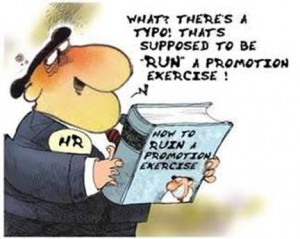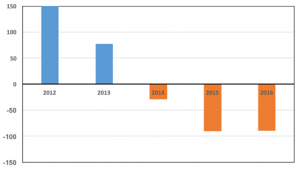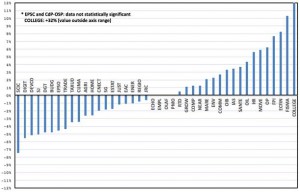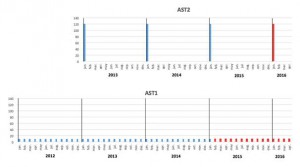Administrative Notice (AN) No 2016-41 of 15.11.2016 (link), closed the 2016 promotion exercise with the publication of the list of colleagues promoted this year: R&D congratulates these 4,852 colleagues!
Does however everything work well? Although the recent Staff Survey does not answer it directly (and for good reason since the question is not judiciously asked …), the more than 1,000 appeals introduced during this exercise make it doubtful. Will DG HR analyze the results of this exercise, inform the staff and identify opportunities for improvement? On the basis of previous exercises, we can surely doubt it! R&D therefore delivers its first analysis on the major issues that require corrective action as of next exercise.
The yo-yo game of calculating quotas :
Do you think that your merits are the criterion that will decide your promotion? False! Your chances (this is the exact word to use) of being promoted depend primarily on this quota calculation. Your grade is largely endowed with quotas for promotions: you are likely to be promoted! And even to be promoted faster than the average speed expected in your grade. Conversely, if your grade receives few promotions, you will have to wait another year, even if your evaluations are very positive.
The proof with grade AD10: the graph below illustrates the difference between the quotas allocated in this grade and the number of AD10 colleagues having reached (or exceeded) the seniority expected before promotion in the grade:
In 2012, quotas far exceeded the number of officials who have reached seniority. The result: 88% of colleagues promoted that year got a fast promotion and only 10 colleagues with 4 years of seniority were not promoted.
In 2016 (as in 2015) quotas were much lower than the number of officials with 4 years’ seniority in the grade. The result: the number of fast promotions fell drastically (20%), 95 colleagues with 4 years of seniority were not promoted and the number of appeals approached the hundred.
Were AD10 colleagues promoted in 2012 much more “performing” than our AD10 colleagues in 2016? It can be doubted, unless the change to 40 hours has caused their productivity to fall sharply…
This demonstration can (unfortunately) be extended to other grades: your merits are not linked to a slow or fast promotion. Is it a fatality? No. It would be sufficient for DG HR to take into account the distribution of the seniorities in the grades in order to refine this calculation of quotas: if necessary, our ESTAT colleagues could provide the necessary assistance…
The distribution of quotas between DGs :
The quota of promotions in your grade is low? You still have a … chance to get your promotion. Indeed, a second important parameter will determine the possibility of being promoted: the distribution of these quotas between DGs.
This distribution is done very simple according to the number of officials eligible for promotion in the grade. Is their seniority in the grade taken into account? Not at all! A DG with 40 officials with 2 years seniority in the grade will receive as many quotas as a DG with 40 officials with 5 years of seniority in the grade. R&D has still not understood the inherent logic of this calculation … which has led in the past to aberrations (link).
In this little game, some DGs do better than others, depending on the distribution of seniority in the grades. R&D had previously published an analysis on the 2015 exercise (link). The graph below illustrates the loss / gain of promotions in 2016 due to the current distribution, compared to a distribution taking into account the seniority in the different grades in the DGs.
Unfortunately, one exercise is not there to catch up with another: DIGIT, SJ, CICS, are still among the losers in 2016 exercise.
Once again, your (non-) promotion will depend on a parameter unrelated to your merits. Again, taking into account seniority in the grades would remedy this inequality.
The (voluntary?) error of seniority for entry grades :
DG HR indicates the average seniority before promotion in each grade (link): they are simply calculated according to the promotion rates defined in the Staff Regulations.
This calculation can seem very simple: a promotion rate of 25 % corresponds to 4 years in a grade before promotion. Similarly, a promotion rate of 33 % corresponds to 3 years in the grade before promotion. In reality, the real seniority calculated by DG HR for the entry grades (AST1 and AD5 in particular) is 6 months higher!
Let us take the example of grades AST1 and AST2: the promotion rates for each of these grades are identical and equal to 33 %. According to the formula used by DG HR, the number of promotions in 2016 will be equal to 33 % of the active population on 1 January 2015:
- a stable population of 360 AST2 (120 promoted each year in this grade on 1 January) will lead to 120 promotions (360 x 33 %) to the higher grade for this year. Thus, the 120 officials promoted to AST2 in 2013 could be promoted to AST3 in 2016, with an average seniority of 3 years;
- the same stable population of 360 AST1 (120 AST1 recruited each year, or an average of 10 per month) will lead to 120 promotions only if it includes civil servants recruited in 2012. Almost all civil servants recruited in 2015 will not be taken into account since they were not active on 1 January 2015, unlike grade AST2. Consequently, these 120 promotions will make it possible to promote the 120 civil servants recruited in 2012, i.e. a real average seniority of 3 years and 6 months !
Similarly, the quotas calculated by DG HR in grade AD5 make it possible, on average, to promote colleagues having six months more than announced. In reality, the DGs use the cascade system to correct DG HR’s error and thus allow promotion after 3 years in these entry grades. But this operation is not neutral and takes place at the expense of the higher grades.
The solution? Adjust the quotas for these entry grades so that they really correspond to the seniority value displayed … or DG HR must have the courage to indicate that the average seniority of these grades are 6 months higher than those which are currently displayed.
The promotion exercise can only gain in credibility with the corrections suggested above: the painful impression / reality of “lottery” left by previous exercises can not become the feeling that prevails at the launch of the exercise. R&D will continue to inform you in the coming weeks about the other highlights of the promotion / reclassification / senior expert-assistant 2016 exercises.




